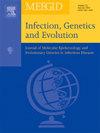从印度南部制药业废水和环境样本中分离出的细菌的抗菌药耐药性分析。
IF 2.6
4区 医学
Q3 INFECTIOUS DISEASES
引用次数: 0
摘要
该研究旨在确定从印度南部制药业周围的进水样本(25 个)、污水样本(15 个)、地表水和地下水样本(15 个)中分离出的细菌的表型和基因型抗菌药耐药性。从 55 个样本中分离出了 10 种不同细菌的 48 个菌株。经鉴定的细菌分离物有:肺炎克雷伯氏菌、铜绿假单胞菌、产气肠杆菌、棒状杆菌、醋氨单胞菌、点状气单胞菌、Ralstonia picketti、金黄色葡萄球菌、嗜麦芽血单胞菌和自由柠檬酸杆菌。通过对 16 种不同抗生素的抗药性测试,对表型进行了分析。采用标准 PCR 技术检测了 12 个耐药基因,包括碳青霉烯类、喹啉类、氨基糖苷类、β-内酰胺类的 blaOXA-58、blaOXA-22、qnrA、qnrB、aac(6)-Ib-cr、aac(3)-XI、mec A、qepA、aadB、blaVIM、blaOXA-48 和 blaNDM。铜绿假单胞菌(1: TN/I/2020)显示存在 3 个抗性基因,其中最多的 7 个分离株存在 qnrB(489 bp)基因,6 个分离株存在 blaVIM(196 bp)基因。抗性基因 blaNDM(621 bp)存在于 3 个不同的分离物中;在本研究获得的细菌分离物中,抗性基因 aac (X):6)-lb-cr (482 bp)、qepA (495 bp)、aadB (500 bp)、blaOXA-58 (843 bp) 分别存在于 2 个不同的分离物中。用 AST 法进行表型耐药性分析时,在测试的 16 种抗生素中,14 种显示出耐药性。同样,在耐药性基因型分析中,在检测的 12 个耐药性基因中,铜绿假单胞菌最多出现了 3 个耐药性基因。不同抗生素的表型耐药性和基因型耐药性与其耐药基因之间存在正负相关,表明耐药基因的表达存在差异。本文章由计算机程序翻译,如有差异,请以英文原文为准。
Antimicrobial resistance profiling of bacteria isolated from wastewater and samples of pharmaceutical industries in South India
The study was aimed to determine the phenotypic and genotypic antimicrobial resistance in the isolated bacteria from the influent (25), effluent (15), surface and ground water samples (15) surrounding the pharmaceutical industries located in south India. From 55 samples, 48 isolates of 10 different bacteria were obtained. The identified bacterial isolates were viz. Klebsiella pneumoniae, Pseudomonas aeruginosa, Enterobacter aerogenes, Corynebacterium sp., Acinetobacter sp., Aeromonas punctata, Ralstonia picketti, Staphylococcus aureus, Stenotrophomonas maltophillia, and Citrobacter freundii. The phenotypic profile of resistance through antibiotic susceptibility test was carried out against sixteen different antibiotics. Standard PCR technique was used for the detection of 12 resistance genes encoding carbapenems, quinoline, aminoglycoside, β-lactam belonging blaOXA-58, blaOXA-22, qnrA, qnrB, aac(6)-Ib-cr, aac (3)-XI, mec A, qepA, aadB, blaVIM, blaOXA-48 and blaNDM. Pseudomonas aeruginosa (1: TN/I/2020) showed presence of 3 resistance genes. qnrB (489 bp) gene was present in maximum of 7 isolates while blaVIM (196 bp) gene was present in 6 isolates. The resistance genes blaNDM (621 bp) was present in three different isolates; aac (X):6)-lb-cr (482 bp), qepA (495 bp), aadB (500 bp), blaOXA-58 (843 bp) resistant genes were present in two different isolates each among the bacterial isolates obtained in this study. In phenotypic resistance profiling by AST method, out of 16 antibiotics tested, 14 showed resistance. Similarly, in genotypic resistance profiling, among 12 resistance genes tested, a maximum of three resistance genes were noticed in Pseudomonas aeruginosa. There were positive and negative correlations observed between phenotypic and genotypic resistance among different antibiotics and their resistance genes indicating the variations in the resistance gene expression.
求助全文
通过发布文献求助,成功后即可免费获取论文全文。
去求助
来源期刊

Infection Genetics and Evolution
医学-传染病学
CiteScore
8.40
自引率
0.00%
发文量
215
审稿时长
82 days
期刊介绍:
(aka Journal of Molecular Epidemiology and Evolutionary Genetics of Infectious Diseases -- MEEGID)
Infectious diseases constitute one of the main challenges to medical science in the coming century. The impressive development of molecular megatechnologies and of bioinformatics have greatly increased our knowledge of the evolution, transmission and pathogenicity of infectious diseases. Research has shown that host susceptibility to many infectious diseases has a genetic basis. Furthermore, much is now known on the molecular epidemiology, evolution and virulence of pathogenic agents, as well as their resistance to drugs, vaccines, and antibiotics. Equally, research on the genetics of disease vectors has greatly improved our understanding of their systematics, has increased our capacity to identify target populations for control or intervention, and has provided detailed information on the mechanisms of insecticide resistance.
However, the genetics and evolutionary biology of hosts, pathogens and vectors have tended to develop as three separate fields of research. This artificial compartmentalisation is of concern due to our growing appreciation of the strong co-evolutionary interactions among hosts, pathogens and vectors.
Infection, Genetics and Evolution and its companion congress [MEEGID](http://www.meegidconference.com/) (for Molecular Epidemiology and Evolutionary Genetics of Infectious Diseases) are the main forum acting for the cross-fertilization between evolutionary science and biomedical research on infectious diseases.
Infection, Genetics and Evolution is the only journal that welcomes articles dealing with the genetics and evolutionary biology of hosts, pathogens and vectors, and coevolution processes among them in relation to infection and disease manifestation. All infectious models enter the scope of the journal, including pathogens of humans, animals and plants, either parasites, fungi, bacteria, viruses or prions. The journal welcomes articles dealing with genetics, population genetics, genomics, postgenomics, gene expression, evolutionary biology, population dynamics, mathematical modeling and bioinformatics. We also provide many author benefits, such as free PDFs, a liberal copyright policy, special discounts on Elsevier publications and much more. Please click here for more information on our author services .
 求助内容:
求助内容: 应助结果提醒方式:
应助结果提醒方式:


